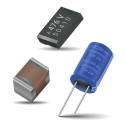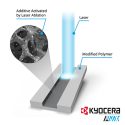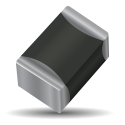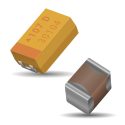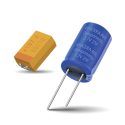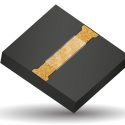Surface Mount Capacitors for DC-DC Converter Applications Written By: Naotaka Hata Abstract: Tantalum, polymer, ceramic, film, and aluminum capacitors each offer a different set of operating and performance characteristics. Choosing the proper capacitor when designing DC-DC converters requires a careful understanding of these differences. High voltage front-end connections to the power source typically rely on aluminum capacitors, while intermediate step-down voltages often look towards the tantalum and ceramic families to take advantage of volumetric efficiency. The final load decoupling and bypass capacitors are generally found in the ceramic and film families. Surface mount (SMD) capacitors can be constructed using several different technologies to achieve a range of voltage tolerance, bulk capacitance, and parasitic device characteristics. As shown in Figure 1,
Application Based
Laser Direct Structuring (LDS): Working Principles and Benefits for RF Applications Written By: Youssef Laamimat Abstract: The growing prevalence of electronic devices presents a challenge to numerous industries and markets. Addressing the industry’s need for lighter and more compact components, LDS stands out as an excellent choice. In addition, it accelerates prototype production and streamlines time-to-market. Laser Direct Structuring (LDS) technology is a revolutionary approach offering a streamlined and efficient process for creating complex 3D circuits on a myriad of substrates. LDS technology is ideal when more curves are needed or less 3D volume is available. In RF applications such as antennas, this allows the manufacture of highly intricate designs, reduces assembly costs of having the antenna outside the device,
Miniature MLVs for Advanced Driver Assistance Systems Written By: Sudhama Dharmappa Abstract: Advanced Driver Assistance Systems (ADAS) have been used to enhance vehicle safety and performance long before the pursuit of self-driving cars. Since the moment electronic sensors were integrated into automotive designs, a variety of driver assistance techniques have been widely adopted, including anti-lock braking, traction control, and cruise control.
Replacing Aluminum Electrolytic Capacitors with Tantalum or Ceramic Capacitors Written By: Teddy Won Abstract: Like all capacitors, electrolytics (e-caps) are based on the principle of storing energy in an electric field using a voltage applied across a dielectric. This paper discusses the basic structure and characteristics of electrolytics and shows alternates for circuit use.
Tantalum and SuperCapacitors Enable Maintenance Free Microcontrollers Written By: Ron Demcko | Daniel West | Ashley Stanziola Abstract: Ultra-low-power microcontroller families now exist with such low power requirements that they can be powered by energy harvesting rather than battery-operated or conventional mains. These powerful MCUs enable maintenance-free control systems in applications ranging from structure/soil/water/air monitoring applications to industrial point controllers (such as smart faucets) to wearable electronics, location tracking, and even BLE beacons.
Energy Storage Capacitor Technology Comparison and Selection Written By: Daniel West| Ussama Margieh Abstract: Tantalum, MLCC, and super capacitor technologies are ideal for many energy storage applications because of their high capacitance capability. These capacitors have drastically different electrical and environmental responses that are sometimes not explicit on datasheets or requires additional knowledge of the properties of materials used, to select the best solution for a given design.
KYOCERA AVX Varistors for Automotive Ethernet Written By: Akihiro Kado | Michael Kirk Abstract: The ubiquity of high-performance sensor systems in modern automobiles (particularly electric and self-driving vehicles) has created immense pressure to develop automotive local area networking (LAN) solutions that offer high bandwidth, low latency, and low cost. Traditional wiring harnesses have become too heavy and complex to support these data and power needs.
Passive Automotive Electronics for 48V Systems and V2X Written By: James Emerick Abstract: Two of the driving forces behind the quickly evolving automotive industry are fuel efficiency and safety. Fuel efficiency is primarily driven by a combination of regulatory requirements for reduced CO2 emissions and consumer demands for improved operational economy. While always paramount, safety has seen renewed activity due to the advancements of driver-assist and driverless technologies. The shift toward 48V subsystems and the integration of vehicle-to-everything (V2X) communication are two prime examples of significant advances in efficiency and safety, respectively. In both cases, new classes of electronic passives (capacitors, inductors, antennas, interconnect) are required to bring these technologies to mainstream products while meeting strict automotive regulatory standards.
Passive Components for GaN Based Devices Written By: Ron Demcko | Daniel West Abstract: The theoretical limits of Silicon-based device performance are fast approaching, and in some cases, already here. Therefore, IC (integrated circuit) design companies have turned their efforts into driving costs down while increasing the performance of wide band gap semiconductors such as GaN (Gallium Nitride). GaN based power and RF (Radio Frequency) devices are now available from multiple manufacturers at affordable prices due to those intensive efforts. Multiple sources have documented GaN based semiconductor performance advantages of faster speed, lower loss, and higher frequency-voltage-temperature operation. Those advantages are, in turn, enabling end systems that have enhanced performance on lower power consumption levels in smaller and lighter packages,
